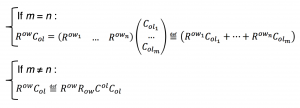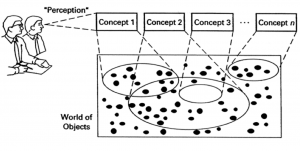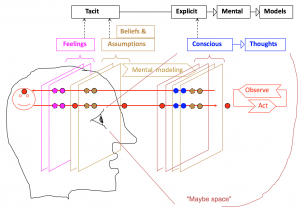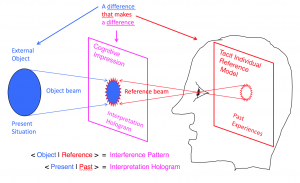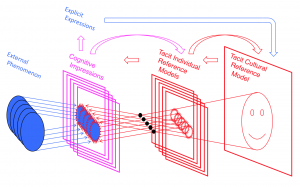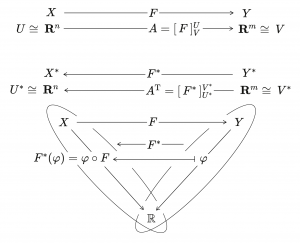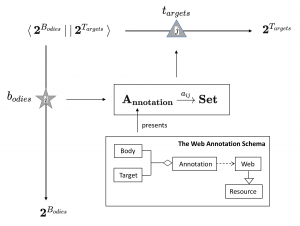This is a sub-page of our page on Algebra.
///////
The sub-pages of this page are:
• The Universal Knowledge Evolution Process
• Foresight and Hindsight Process Manager
• Knowlecules
• Knowledge Tentacles
• The Relational Chain Rule
• Activities and Participators in a Community
///////
Related KMR-pages:
• Business Algebra
• Discourse Algebra
• Social Algebra
• Social Calculus
• Disambiguating Equality
• Disambiguating Minus
• Disambiguating Plus
///////
Other related sources of information:
• But what is a Neural Network (3Blue1Brown on YouTube)
///////
Representation and Reconstruction of a Presentant with respect to a Background
Representation: \, [ \, p_{resentant} \, ]_{B_{ackground}} \, \mapsto \, \left< \, r_{epresentant} \, \right>_{B_{ackground}}
Reconstruction: \, \left( \, \left< \, r_{epresentant} \, \right>_{B_{ackground}} \, \right)_{B_{ackground}} \mapsto \,\, p_{resentant}
/////// In Swedish:
Representation och Rekonstruktion av en Presentant med hjälp av en Bakgrund
Representation: \, [ \, p_{resentant} \, ]_{B_{akgrund}} \, \mapsto \, \left< \, r_{epresentant} \, \right>_{B_{akgrund}}
Rekonstruktion: \, \left( \, \left< \, r_{epresentant} \, \right>_{B_{akgrund}} \, \right)_{B_{akgrund}} \mapsto \,\, p_{resentant}
/////// Back to English:
///////
Knowledge Algebra is a matrix-based mathematical framework that enables dynamic overview of the model that you are developing (or executing) as well as combinatorial control over the options from which the successive choices are made.
Modeling in KA consists of constructing ‘knowlecules’, which represent separate chunks or ‘molecules’ of encoded knowledge or behaviour. A knowlecule is a type of matrix (specifically a named adjacency matrix). The thing whose name appears in the position \, [i, k] \, of the matrix indicates that there is a relationship between the things whose names appear in row \, i \, and column \, k .
Being matrices, knowlecules can be combined in various ways according to the rules of matrix algebra. Since the things behind the names can be anything, anything that can be named can be modeled in knowledge algebra. This includes all chains of (possibly) relevant relations between all parameters that have been introduced in the model. Moreover, such relational chains can be evaluated both contextually and symbolically, allowing each symbol of a formal computation to change its relevance dynamically – by being connected to context-specific evaluations that bring in dynamic information from the outside. This feature of emerging relevance is at the heart of knowledge algebra. A good illustration of the power of this way of modeling is provided by the Ericsson AXE10 delay.
Moreover, through the use of feedback loops, knowledge algebra can support the construction of knowlecules that loop back on themselves. Such loops are well suited to model the ongoing shift in manufacturing, away from today’s traditional, linear, cause-effect oriented production models and towards more sustainable production models that are interacting with the emerging circular economy with its characteristic loops of systemic feedback. The same goes, of course, for modeling various effects of climate change.
Through their symbolic features, knowlecules provide the capacity necessary to represent arbitrarily complex combinations of capabilities. This includes the capability to acquire new capabilities, which might arise through access to ‘blended intelligence‘, that is intelligent blends between human (= genuine) and machine (= artificial) intelligence.
Knowledge Algebra provides a fully symbolic system that can model anything that can be talked about. In KA, both parameters and arguments are turned into formal symbols, and therefore available for symbolic manipulations of different kinds. Most importantly, fully symbolic systems enable late binding of symbol interpretations, something that can be called ‘lazy semantics‘. This includes conditional interpretation of which types of logic to use, and what kind (if any) of fuzzy methods to introduce. This type of flexibility opens up possibilities for tighter forms of interactions with big data streams and thereby the possibilities for applying more sophisticated forms of distributed artificial intelligence.
///////
The main innovation
When you add two piles of sand, you end up with another (bigger) pile of sand, but when you add an apple and a pear you do not end up with a fruit. However, both of these operations are examples of addition, albeit two different forms of it. The “pile + pile = pile” form of addition is subsumptive, because it subsumes (= merges together) two different things and produces a result of the same type.
The “apple + pear” type of addition does not subsume its terms into a result of the same type. Instead it just adds the things together, as you are adding apples and pears when you put them together in your shopping cart. This type of addition is called formal (or direct) but we will also refer to it as non-subsumptive. More on the difference between subsumptive and non-subsumptive addition can be found at our web site on disambiguating plus.
Knowledge algebra builds on matrix algebra, which deals with the addition and multiplication of matrices. However, instead of making use of the usual, subsumptive forms of addition and multiplication, knowledge algebra makes use of formal, non-subsumptive multiplication and addition in order to multiply two matrices. By doing so, it turns the usual adjacency matrices of graph theory into formal relational matrices. Such matrices can keep track of all chains of relations of possible relevance between the related elements.
As we will see below, building relational chains by consecutively multiplying together the corresponding relational matrices will ensure combinatorial control and requisite variety over all possible (binary) combinations of the introduced parameters. Moreover, the interplay between different parenthetical groupings of the same (associative) product of relational matrices can enable the emergence of relevance by connecting abstract symbols to dynamic evaluations in different contexts. Furthermore, by evaluating the symbols as late as possible, i.e., on an as-needed basis, computational complexity can be kept to a minimum when the number of parameters grows large.
///
///////
Knowledge Algebra in tensor notation:
///////
Interpreting objects through concepts:
Mental modeling:
Interpreting an Object through a Model:
Evolving a Cultural Reference Model:
///////
The React –> Preact –> Act loop:
///////
[p_{resentation}]_{B_{ackground}} = \left<r_{epresentation}\right>_{B_{ackground}}///////</r_{epresentation}\right>
The representation of a \, c_{oncept} \, in \, K_{nowledge} A_{lgebra} \, :
\, { [ \, c_{oncept} \, ] }_{K_{nowledge} A_{lgebra}} \, = \, \vert \, c_{onstraints} \, \rangle \, \langle \, c_{onstraints} \, \vert \, \vert \, c_{onnections} \, \rangle \, \langle \, c_{onnections} \, \vertThis representation will be referred to as a \, k_{nowlecule} .
/////// Web Annotation Data Model:
\, \vert \, {\mathbf 2}^{B_{odies}} \, \rangle \, \langle \, {\mathbf 2}^{B_{odies}} \, \vert \, \vert \, {\mathbf 2}^{T_{argets}} \, \rangle \, \langle \, {\mathbf 2}^{T_{argets}} \, \vert \, \vert \, b_{odies} \, \rangle \, \langle \, b_{odies} \, \vert \, \vert \, t_{argets} \, \rangle \, \langle \, t_{argets} \, \vert \, \langle \, {\mathbf 2}^{B_{odies}} \, \vert \, \vert \, {\mathbf 2}^{T_{argets}} \, \rangle \, \, \langle \, b_{odies} \, \vert \, \vert \, t_{argets} \, \rangle \,///////
\, \mathbf{Set} \; \mathbf{Cat} \; \mathscr{A} \; \mathbf{A}_\mathbf{nnotation} \; \, \mathbf{Cat}^\mathscr{C} \, \, \mathbf{A}_\mathbf{nnotation} \xrightarrow[] {a_{\mathscr{i} \mathscr{j}}} \mathbf{Set} \; \, i \, j \,///////
\, \mathbb{P}\mathbf{rof} \; \mathcal{P}\mathbf{rof} \; \mathbf{Set} \; \mathbf{Cat} \; \mathscr{C} \; \mathbf{C}_\mathbf{onzilla} \; \, \mathbf{Cat}^\mathscr{C} \, \, \mathbf{Cat}^{ \mathbf{2}^{\, c_{onstraints}} } \; \mathbf{Cat}^{ \mathbf{2}^{\, c_{onnections}} } \, \, \mathbf{Cat}^{ \mathbf{2}^{\, o_{ldWays}} } \; \mathbf{Cat}^{ \mathbf{2}^{\, n_{ewWays}} } \, \, \mathbf{C}_\mathbf{onzilla} \xrightarrow[] {C_{\mathscr{I} \mathscr{J}}} \mathbf{Cat} \; \, \mathbf{Cat}^\mathscr{I} \; \mathbf{Cat}^\mathscr{J} \, \, \langle \, c_{onstrain} \, \vert \, \vert \, c_{onnect} \, \rangle \, \, \langle \, o_{ldWays} \, \vert \, \vert \, n_{ewWays} \, \rangle \, \ , \mathbf{R} \, \mathbb{R} \, \mathbf{U} \, \mathbf{U^*} \, \mathbf{V} \, \mathbf{V^*} \, \ , F \, F^* \, A \, A^\top \, A^\text{T} \ , \varphi \, \varphi \circ F \, F^* \, A \, A^\top \, A^\text{T}///////
The adjoint \, F^* \, of \, F \, and its representation as the transposed matrix \, A^\text{T} \, :
///////
///////
///////

